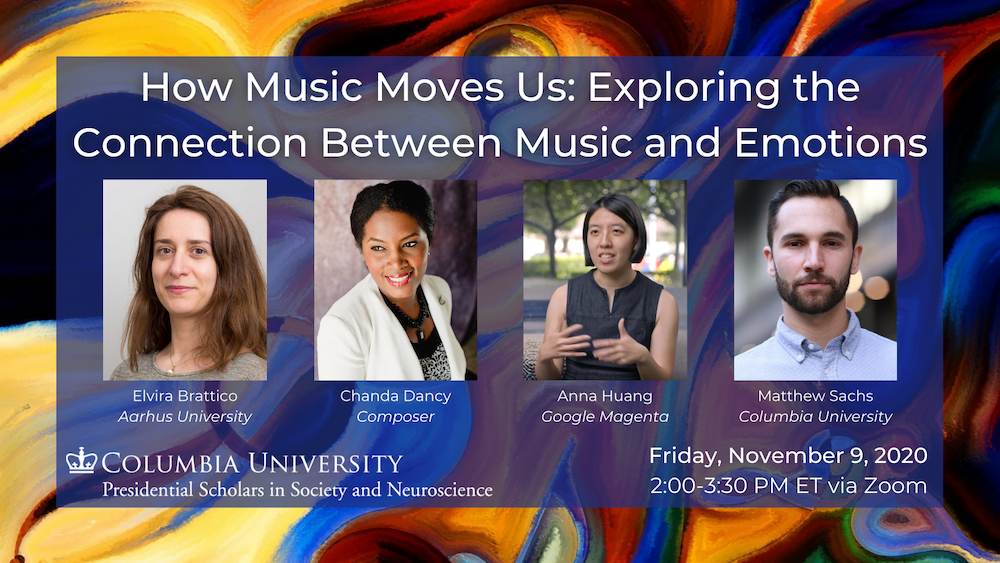How Does Music Move Us?
How can music—essentially just a series of notes—evoke the intense emotions of joy, nostalgia, or sadness? How do certain pieces trigger chills and shivers down our spine even after repeated listens? Why are we sometimes drawn to songs that make us feel sorrow and pain? How is music able to mentally transport us so effortlessly into how we felt in the past? These are just some of the questions scientists have been trying to answer when studying the relationship between music and emotions. At Columbia, Presidential Scholar in Society and Neuroscience Matthew Sachs investigates the neural and behavioral mechanisms involved in emotions and feeling in response to naturalistic stimuli, such as music and sounds in film. On November 9, Sachs and a group of experts in music composition (Chanda Dancy), neuroscience (Elvira Brattico), and machine learning (Anna Huang) will convene virtually to discuss, How Music Moves Us: Exploring the Connection Between Music and Emotions.
Emotions are an integral part of our lives in that they motivate and guide many of our basic human behaviors, some of which may be socially inappropriate or maladaptive. Despite the importance of understanding emotions, it has been challenging to study them in the context of the laboratory setting. As Sachs explains, “psychological and neuroscientific studies of emotions have, thus far, produced conflicting and ambiguous results, extending the century-long debate as to what emotions are and how best to study them.” However, music may provide a unique experimental lens with which to study emotions. “[Music] can convey and induce a range of emotional states that change over time in a confined and contained amount of time. In that way, the emotions experienced in response to music are dynamic and complex, more akin to how we experience emotions in everyday life.” Studying how people listen and feel in response to music which is controlled and altered in very specific ways may therefore help researchers observe and measure more naturalistic emotional experiences.
To learn more about how a composer uses music to convey and create emotions, we reached out to speaker Chanda Dancy, a composer working in film and television, and, more recently, composing classical concert pieces.
It is a very collaborative process. Directors tell the story and emotion through pictures, and composers tell the story through manipulated soundwaves! Orchestra members are typically just one part of the sound making process. In my experience, one can create an emotional response with even recording household sounds and processing them to create a whole unique "instrument."
My lived life experience has 100% shaped the composer that I am today. Emotional experience and awareness are key. One must have empathy; when you're telling a story about a character's lived experience, you have to have the empathetic tools to put yourself in that character's shoes, and create their sonic world. Without that empathy, film music would fall flat.
That is where the collaborative part of the process comes in. The director, producers, editors and other key production personnel will give feedback on music cues, letting me know how the music made them feel, and I figure out how to tailor the sounds to create the response that we want an audience member to feel.
I am certain that when people really understand the effects of music, we would have so much more respect for it in the public educational system. Plato identified such with the Quadrivium—music is an integral part in understanding the universe. So whatever means necessary to help human society understand exactly why that is, would certainly be beneficial.
Absolutely. And it is both a sonic language and a written language. Just like learning to speak English or Japanese, you have to hear it all of the time, and observe it to understand its nuance. And just like learning your ABCs, and how to read, music is also a language of whole notes, half notes, quarter notes, staff lines, etc.!
I am really looking forward to learning from other seminar speakers! I find it fascinating to learn about the science and philosophy behind what I do intuitively!
Sachs hopes that attendees learn something new about their own personal experiences with music and take away a key message about interdisciplinarity from this upcoming event. “Very often, when psychologists and neuroscientists talk about emotions in music, they fail to consider the many complex social and contextual factors that could influence the emotional experience. Composers and musicians are adept at making listeners feel an intended emotion through their performance or compositions, yet [they] may have difficulty explaining what an emotion is or why people feel that way. Likewise, experiments and results from engineering, in which researchers try to reproduce the musical creativity process with machines, can provide an additional level of insight into this process.” By bringing together scholars with different expertise and perspectives around a topic in music that touches almost everyone, Sachs is optimistic that these new connections will generate insights that will enhance the outputs of their respective work.
To hear more from Chanda Dancy and Matthew Sachs, be sure to join our virtual event on November 9 at 2PM ET, How Music Moves Us: Exploring the Connection Between Music and Emotions. The event is free and open to the public; registration is required.
This event is part of the Seminars in Society and Neuroscience series.

